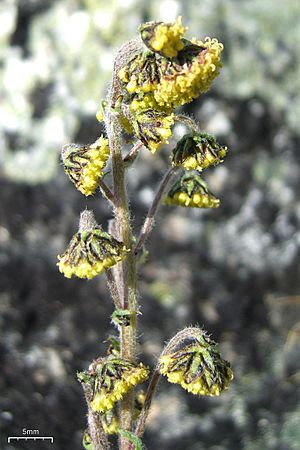Alpine sagewort facts for kids
Quick facts for kids Alpine sagewort |
|
|---|---|
 |
|
| Scientific classification | |
| Genus: |
Artemisia
|
| Species: |
norvegica
|
| Synonyms | |
|
|
The alpine sagewort (Artemisia norvegica) is a type of flowering plant. It belongs to the aster family, which includes daisies and sunflowers. People also call it boreal sagewort, mountain sagewort, Norwegian mugwort, arctic wormwood, and spruce wormwood.
This plant grows in very cold places. You can find it in parts of Eurasia, like Scotland, Scandinavia, and the Ural Mountains in Russia. It also lives in high mountains and cold northern areas of North America. This includes places like Nunavut, Yukon, Alaska, British Columbia, Alberta, Washington, Montana, Wyoming, and California.
Contents
What Does Alpine Sagewort Look Like?
The alpine sagewort is a subshrub, which means it's a small, woody plant. It can grow from about 20 to 60 centimeters (8 to 24 inches) tall. It has straight stems that grow from a thick base called a caudex and a deep main root.
Most of its leaves are found low on the stems. These leaves can be from 2 to 20 centimeters (about 1 to 8 inches) long. The plant produces flower heads that hang down. These heads have two kinds of tiny flowers: ray florets and disc florets. The ray florets are female, while the disc florets in the middle have both male and female parts.
Alpine sagewort spreads in two ways. It can make new plants from its seeds, which are carried by the wind. It can also spread using stolons, which are special stems that grow along the ground and can root to form new plants.
Where Alpine Sagewort Lives
This plant likes cold places. It grows in subalpine and alpine climates, which are found in mountains. It also lives in Arctic areas like the tundra. You can find it in rocky areas, alpine meadows, and places with lots of grasses and sedges.
In Alaska, alpine sagewort grows near fjords, which are narrow inlets of the sea. It often grows with other plants like larkspur monkshood, Eschscholtz's buttercup, and Canadian burnet. On Alaskan mountains, such as the Kenai Mountains, it grows alongside grasses, sedges, and willows.
In the cold alpine tundra of the Rocky Mountains, it can be found in areas where snow stays late. It also grows on turf made of plants like blackroot sedge and alpine clover. In the mountains of the Northwest Territories, it grows among lichens and grasses like arctic bluegrass.
Animals That Eat Alpine Sagewort
Many animals enjoy eating alpine sagewort. Mountain goats eat it during the summer in Alaska. Sitka black-tailed deer and hoary marmots also feed on this plant.
How Alpine Sagewort Helps Nature
Alpine sagewort is a "pioneer species." This means it's one of the first plants to grow in areas that have been disturbed. For example, it can grow in plains that have been washed clean by floods. It has even been seen growing in bare soil where vehicles have driven. It was used to help plants grow back along the Trail Ridge Road in Colorado after it was built.
Types of Alpine Sagewort
There are two main types, or subspecies, of alpine sagewort:
- Artemisia norvegica subsp. norvegica
- Artemisia norvegica subsp. saxatilis
See also
 In Spanish: Artemisia norvegica para niños
In Spanish: Artemisia norvegica para niños

